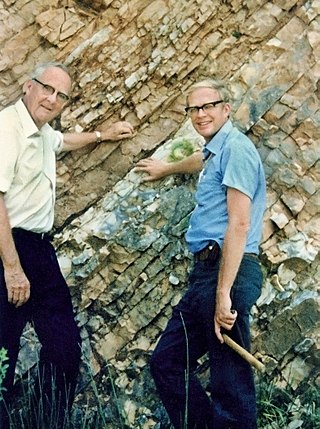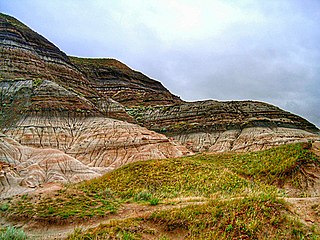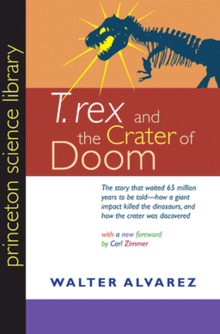
The Deccan Traps is a large igneous province of west-central India. It is one of the largest volcanic features on Earth, taking the form of a large shield volcano. It consists of numerous layers of solidified flood basalt that together are more than about 2,000 metres (6,600 ft) thick, cover an area of about 500,000 square kilometres (200,000 sq mi), and have a volume of about 1,000,000 cubic kilometres (200,000 cu mi). Originally, the Deccan Traps may have covered about 1,500,000 square kilometres (600,000 sq mi), with a correspondingly larger original volume. This volume overlies the Archean age Indian Shield, which is likely the lithology the province passed through during eruption. The province is commonly divided into four subprovinces: the main Deccan, the Malwa Plateau, the Mandla Lobe, and the Saurashtran Plateau.

An impact event is a collision between astronomical objects causing measurable effects. Impact events have physical consequences and have been found to regularly occur in planetary systems, though the most frequent involve asteroids, comets or meteoroids and have minimal effect. When large objects impact terrestrial planets such as the Earth, there can be significant physical and biospheric consequences, though atmospheres mitigate many surface impacts through atmospheric entry. Impact craters and structures are dominant landforms on many of the Solar System's solid objects and present the strongest empirical evidence for their frequency and scale.

The Chicxulub crater is an impact crater buried underneath the Yucatán Peninsula in Mexico. Its center is offshore, but the crater is named after the onshore community of Chicxulub Pueblo. It was formed slightly over 66 million years ago when a large asteroid, about ten kilometers in diameter, struck Earth. The crater is estimated to be 180 kilometers in diameter and 20 kilometers in depth. It is the second largest confirmed impact structure on Earth, and the only one whose peak ring is intact and directly accessible for scientific research.

Walter Alvarez is a professor in the Earth and Planetary Science department at the University of California, Berkeley. He is most widely known for the theory that dinosaurs were killed by an asteroid impact, developed in collaboration with his father, Nobel Prize–winning physicist Luis Alvarez.
A verneshot is a hypothetical volcanic eruption event caused by the buildup of gas deep underneath a craton. Such an event may be forceful enough to launch an extreme amount of material from the crust and mantle into a sub-orbital trajectory, leading to significant further damage after the material crashes back down to the surface.

Silverpit crater is a buried sub-sea structure under the North Sea off the coast of the island of Great Britain. The 20 km (12 mi) crater-like form, named after the Silver Pit—a nearby sea-floor valley recognized by generations of fishermen—was discovered during the routine analysis of seismic data collected during exploration for gas in the Southern North Sea Sedimentary Basin.
The Shiva crater is the claim by paleontologist Sankar Chatterjee and colleagues that the Bombay High and Surat Depression on the Indian continental shelf west of Mumbai, India represent a 500-kilometre (310 mi) impact crater, that formed around the Cretaceous-Paleogene boundary. Chatterjee and colleagues have claimed that this could have contributed to the K-Pg extinction event. Other scholars have questioned the claims, finding that there is no evidence of an impact structure.

The Alvarez hypothesis posits that the mass extinction of the non-avian dinosaurs and many other living things during the Cretaceous–Paleogene extinction event was caused by the impact of a large asteroid on the Earth. Prior to 2013, it was commonly cited as having happened about 65 million years ago, but Renne and colleagues (2013) gave an updated value of 66 million years. Evidence indicates that the asteroid fell in the Yucatán Peninsula, at Chicxulub, Mexico. The hypothesis is named after the father-and-son team of scientists Luis and Walter Alvarez, who first suggested it in 1980. Shortly afterwards, and independently, the same was suggested by Dutch paleontologist Jan Smit.
Gerta Keller is a geologist and paleontologist who contests the Alvarez hypothesis that the impact of the Chicxulub impactor, or another large celestial body, directly caused the Cretaceous–Paleogene extinction event. Keller maintains that such an impact predates the mass extinction and that Deccan volcanism and its environmental consequences were the most likely major cause, but possibly exacerbated by the impact.
The term iridium anomaly commonly refers to an unusual abundance of the chemical element iridium in a layer of rock strata at the Cretaceous–Paleogene (K–Pg) boundary. The unusually high concentration of a rare metal like iridium is often taken as evidence for an extraterrestrial impact event.

The Cretaceous–Paleogene (K–Pg) boundary, formerly known as the Cretaceous–Tertiary (K–T) boundary, is a geological signature, usually a thin band of rock containing much more iridium than other bands. The K–Pg boundary marks the end of the Cretaceous Period, the last period of the Mesozoic Era, and marks the beginning of the Paleogene Period, the first period of the Cenozoic Era. Its age is usually estimated at 66 million years, with radiometric dating yielding a more precise age of 66.043 ± 0.011 Ma.

Marker horizons are stratigraphic units of the same age and of such distinctive composition and appearance, that, despite their presence in separate geographic locations, there is no doubt about their being of equivalent age (isochronous) and of common origin. Such clear markers facilitate the correlation of strata, and used in conjunction with fossil floral and faunal assemblages and paleomagnetism, permit the mapping of land masses and bodies of water throughout the history of the earth. They usually consist of a relatively thin layer of sedimentary rock that is readily recognized on the basis of either its distinct physical characteristics or fossil content and can be mapped over a very large geographic area. As a result, a key bed is useful for correlating sequences of sedimentary rocks over a large area. Typically, key beds were created as the result of either instantaneous events or very short episodes of the widespread deposition of a specific types of sediment. As the result, key beds often can be used for both mapping and correlating sedimentary rocks and dating them. Volcanic ash beds and impact spherule beds, and specific megaturbidites are types of key beds created by instantaneous events. The widespread accumulation of distinctive sediments over a geologically short period of time have created key beds in the form of peat beds, coal beds, shell beds, marine bands, black shales in cyclothems, and oil shales. A well-known example of a key bed is the global layer of iridium-rich impact ejecta that marks the Cretaceous–Paleogene boundary.

Frank Asaro was an Emeritus Senior Scientist at the Lawrence Berkeley National Laboratory associated with the University of California at Berkeley. He is best known as the chemist who discovered the iridium anomaly in the Cretaceous–Paleogene boundary layer that led the team of Luis Alvarez, Walter Alvarez, Frank Asaro, and Helen Michel to propose the Asteroid-Impact Theory, which postulates that an asteroid hit the Earth sixty-five million years ago and caused mass extinction during the age of the dinosaurs.
The climate across the Cretaceous–Paleogene boundary is very important to geologic time as it marks a catastrophic global extinction event. Numerous theories have been proposed as to why this extinction event happened including an asteroid known as the Chicxulub asteroid, volcanism, or sea level changes. While the mass extinction is well documented, there is much debate about the immediate and long-term climatic and environmental changes caused by the event. The terrestrial climates at this time are poorly known, which limits the understanding of environmentally driven changes in biodiversity that occurred before the Chicxulub crater impact. Oxygen isotopes across the K–T boundary suggest that oceanic temperatures fluctuated in the Late Cretaceous and through the boundary itself. Carbon isotope measurements of benthic foraminifera at the K–T boundary suggest rapid, repeated fluctuations in oceanic productivity in the 3 million years before the final extinction, and that productivity and ocean circulation ended abruptly for at least tens of thousands of years just after the boundary, indicating devastation of terrestrial and marine ecosystems. Some researchers suggest that climate change is the main connection between the impact and the extinction. The impact perturbed the climate system with long-term effects that were much worse than the immediate, direct consequences of the impact.

Stevns Klint, known as the Cliffs of Stevns in English, is a white chalk cliff located some 6 km (3.7 mi) southeast of Store Heddinge on the Danish island of Zealand. Stretching 17 km (11 mi) along the coast, it is of geological importance as one of the best exposed Cretaceous-Tertiary (K/T) boundaries in the world. Subject to frequent erosion, the cliff rises to a height of up to 40 m (130 ft). Because of its exceptional fossil record, Stevens Klint was inscribed on the UNESCO World Heritage List in 2014.

The Cretaceous–Paleogene (K–Pg) extinction event, also known as the Cretaceous–Tertiary(K–T)extinction, was a sudden mass extinction of three-quarters of the plant and animal species on Earth, approximately 66 million years ago. The event caused the extinction of all non-avian dinosaurs. Most other tetrapods weighing more than 25 kilograms also became extinct, with the exception of some ectothermic species such as sea turtles and crocodilians. It marked the end of the Cretaceous period, and with it the Mesozoic era, while heralding the beginning of the Cenozoic era, which continues to this day.

Since the 19th century, a significant amount of research has been conducted on the Cretaceous–Paleogene extinction event, the mass extinction that ended the dinosaur-dominated Mesozoic Era and set the stage for the Age of Mammals, or Cenozoic Era. A chronology of this research is presented here.
Tanis is a paleontological site in southwestern North Dakota, United States. It is part of the heavily studied Hell Creek Formation, a geological region renowned for many significant fossil discoveries from the Upper Cretaceous and lower Paleocene. Uniquely, Tanis appears to record in detail, extensive evidence of the direct effects of the giant Chicxulub asteroid impact which struck the Gulf of Mexico 66.043 million years ago, and wiped out all non-avian dinosaurs and many other species. The extinction event caused by this impact began the Cenozoic, in which mammals - including humans - would eventually come to dominate life on Earth.
Alan Russell Hildebrand is a planetary scientist and Associate Professor in the Department of Geoscience at the University of Calgary. He has specialized in the study of asteroid impact cratering, fireballs and meteorite recovery. His work has shed light on the extinction event caused by the Chicxulub asteroid at the end of the Cretaceous period. Hildebrand is one of the leaders of the Prairie Meteorite Network search project.
Dinosaurs: The Final Day with David Attenborough is a British documentary programme that aired on BBC One on 15 April 2022. Presented by David Attenborough, the documentary follows the final days of non-avian dinosaurs through the Cretaceous–Paleogene extinction event, similar to BBC's Prehistoric Planet. Like that series, the programme's creatures were also made with computer-generated imagery.










